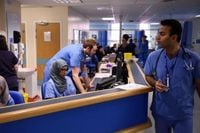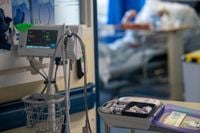Scotland’s health system is facing a reckoning. More than 800 deaths last year have been linked to prolonged waits in Accident & Emergency (A&E) departments across the country, according to a sobering analysis by the Royal College of Emergency Medicine (RCEM). The data—released alongside the RCEM’s manifesto ahead of the 2026 Holyrood election—paints a grim picture of a system under unrelenting pressure, with patients and families bearing the brunt of the crisis.
The RCEM’s findings, published by outlets including BBC News and The Scotsman, show that in 2024, a record 76,510 people in Scotland waited longer than 12 hours in emergency departments. That’s a staggering increase of 20,432 from the previous year. Of those, 58,906 were waiting to be admitted to a ward for further care. Using a standard mortality ratio—which estimates one death for every 72 patients who endure an eight to 12-hour wait—the RCEM calculated that 818 excess deaths were associated with these prolonged stays. That equates to roughly 16 people dying every week due to long A&E waits.
Dr Fiona Hunter, vice president of RCEM Scotland, did not mince words in her assessment. “The fact that the deaths of more than 800 patients have been lost due to a system in crisis is a national tragedy. Behind this statistic are stories of heartbreak. Because these are people. Mums, dads, brothers, sisters, grandparents—their deaths shattering the lives of families and friends,” she said, as quoted by The Scotsman. Dr Hunter went on to describe the ordeal many patients face: “These are patients who are sick and need further care on a ward. So they are forced to endure extreme wait times for an inpatient bed to become available for them. Often, they will be experiencing this, counting the hours they have been in emergency departments, on a trolley in a corridor, cupboard, or simply any available floor space.”
The RCEM’s analysis also found that the crisis is not confined to the winter months, when the NHS typically faces its greatest strain. Even during the summer of 2025, the pressure was relentless. Between June 1 and July 31, 9,881 people endured waits of 12 hours or more in A&E—7,003 more than the entire year of 2018. In July alone, 4,686 patients faced these extreme waits, a figure that dwarfs the numbers from just a few years ago.
For Dr Iain Kennedy, chair of BMA Scotland, these figures are both “extremely concerning” and “tragic but entirely predictable.” He explained, “It is a tragic but entirely predictable outcome of a system in crisis, which leaves doctors facing challenges every single day in providing timely care and patients finding the NHS is not able to provide the care they need, when they need it.” Dr Kennedy also pointed to a workforce crisis, noting that more than 1,000 consultant vacancies exist across Scottish health boards and estimating it would take over 13 years to fill them at the current rate.
As the RCEM released its manifesto, it called for urgent action to end A&E overcrowding. The recommendations include investing in social care to free up hospital beds, focusing on reducing both 12-hour waits and meeting the four-hour target, and ensuring adequate staffing levels across emergency departments. Dr Hunter urged, “We urge all political parties to adopt the recommendations in our manifesto to give Scotland an emergency care system that we can be proud of once again. Because without government action, the cost will continue to be measured in lives.”
The political fallout has been swift and fierce. Scottish Health Secretary Neil Gray acknowledged the crisis and expressed sympathy for those bereaved. “We’ve always recognised the relationship between long A&E waits and increased risk of harm, which is why we remain committed to delivering improved performance and shifting the focus of care from acute to community where better for patients,” he stated, as reported by BBC News. Gray pointed to progress in the latest monthly A&E figures, noting that July 2025 had the lowest number of 8- and 12-hour waits since September 2023. He also highlighted that Scotland’s core A&E departments have consistently outperformed those in England and Wales for the past decade. The government, Gray said, is investing an additional £200 million to further reduce waiting times and will introduce specialist frailty teams in every core A&E. “We’ve also seen the number of Emergency Medicine Consultants in NHS Scotland increasing by 21 per cent in the last four years,” he added.
Yet, opposition politicians have been scathing in their criticism. Scottish Conservative health spokesman Dr Sandesh Gulhane declared, “SNP ministers should hang their heads in shame at these heartbreaking figures, which lay bare the human toll of the SNP’s chronic mismanagement of emergency care. These completely avoidable deaths are the direct result of the nationalists’ abject failure to meet their own A&E targets. Frontline staff are working flat out for their patients, but they’ve been failed by successive SNP health secretaries who still haven’t come up with a credible plan to address this national emergency.”
Scottish Labour health spokesperson Jackie Baillie echoed these sentiments: “This damning analysis lays bare the true cost of SNP failure. For years Scots have been dying as a result of dangerously long waits in A&E, but the SNP has stood idly by while this crisis ran riot. The SNP has no idea how to fix this crisis and our NHS cannot afford a third decade of this incompetence.”
Alex Cole-Hamilton, leader of the Scottish Liberal Democrats, added, “People are waiting excruciatingly long at A&E or even dying before they get treatment because the SNP have failed to fix the crisis. Staff and patients are trapped in pressure cooker conditions. Since the target was last met, there has been a merry-go-round of four SNP health secretaries, but not a single one has ever made a dent.” Cole-Hamilton argued that his party offered concrete solutions, urging voters to support the Liberal Democrats at the next election.
The RCEM’s report and the ensuing debate come at a crucial moment for Scotland’s health service. The crisis in emergency care is not just about numbers or statistics—it is, as Dr Hunter and others have emphasized, about real people and families whose lives have been shattered. The challenge now is whether political leaders, clinicians, and the wider system can come together to implement changes that will prevent further heartbreak and restore public confidence in Scotland’s NHS.
As the nation looks ahead to the next Holyrood election, the fate of emergency care—and the lives it touches—hangs in the balance.





